How to Care for Haworthia: A Beginner’s Guide to These Charming Succulents
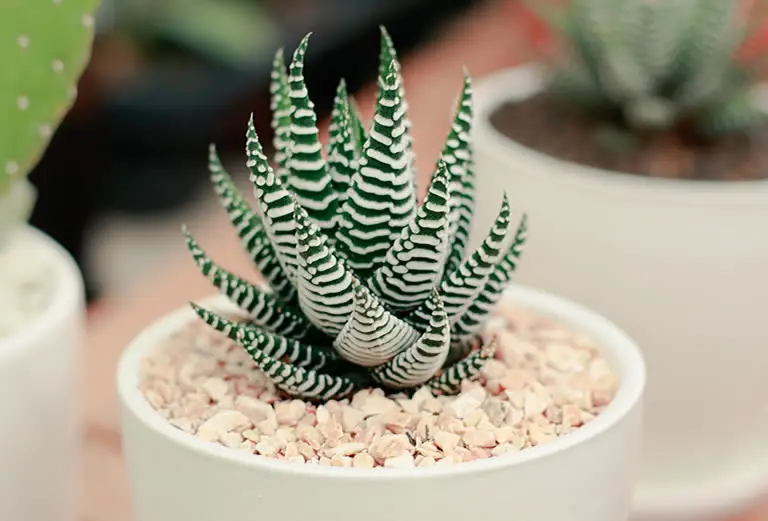
Looking for a low-maintenance succulent that’s perfect for small spaces? Haworthias are compact, stylish, and incredibly easy to grow indoors. Whether you’re just starting your plant journey or looking to expand your succulent collection, this guide will walk you through everything you need to know to keep your Haworthia happy and thriving.
Table of Contents
What Makes Haworthias Special
Haworthias are small, slow-growing succulents native to South Africa, where they thrive in dry, rocky environments under the partial shade of shrubs or rocks.
These compact plants are members of the Asphodelaceae family, closely related to aloes, but with a distinct look thanks to their tightly packed rosettes and ornamental patterns.
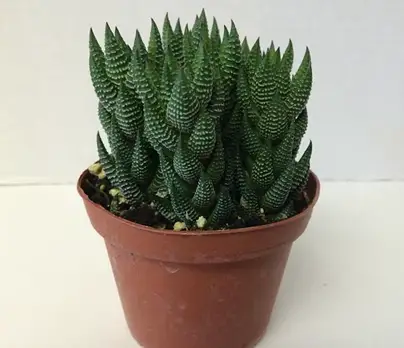
What sets them apart is how beginner-friendly they are.
They adapt well to indoor environments, are low-maintenance, and add a unique touch with their textured, often translucent leaves.
Haworthias are commonly mistaken for Aloe or Zebra plants, especially Haworthia fasciata and attenuata, but their care needs are gentler and more forgiving overall.
Light Requirements
Haworthias prefer bright, indirect light that mimics their natural habitat under rocks and shrubs.
Too much direct sunlight can scorch their leaves, especially in the afternoon, causing them to lose their vibrant patterns and turn reddish or pale.
A spot near an east- or north-facing window works beautifully, though they’ll also do well under grow lights if your home doesn’t get much natural light.
Avoid deep shade, as it can lead to overly stretched growth.
Watering Instructions
These succulents are drought-tolerant and should be watered sparingly.
Let the soil dry out completely between waterings, then give the plant a deep drink.

In general, watering every 2–3 weeks is ideal during spring and summer, while watering once a month or less may be enough in winter.
If you notice leaves becoming soft or translucent, you’re likely overwatering.
Crispy or curling leaves usually signal underwatering.
Soil and Potting
Haworthias require a well-draining soil mix to prevent root rot.
Use a cactus or succulent mix, or create your own by combining two parts coarse sand or perlite with one part potting soil.
Terracotta pots are ideal, as they allow for better airflow and faster moisture evaporation.
Ensure the pot has a drainage hole—Haworthias will not tolerate standing water.
Repotting is only necessary every 2–3 years, and they actually thrive when slightly root-bound.
Fertilizer
Haworthias aren’t heavy feeders, but occasional fertilizing can boost their growth.
Use a balanced, water-soluble succulent fertilizer diluted to half strength.
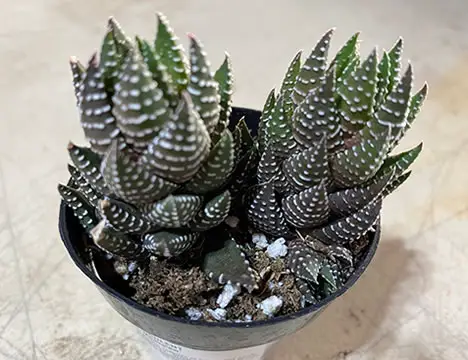
A formula with an NPK ratio around 10-10-10 like this one or 2-7-7 like this one, is great for promoting healthy roots and foliage.
Fertilize once a month during the growing season (spring through early fall).
Skip feeding during the dormant winter period.
Pruning and Maintenance
These low-maintenance plants require very little pruning.
You can gently remove dried or shriveled leaves from the base to keep your plant looking tidy.
Pups (offsets) can be trimmed and repotted to propagate new plants. We outline how to propagate your Haworthia in the article How to Propagate Haworthia (Haworthia spp.): Step-by-Step Guide for Every Method.
Wipe leaves occasionally with a soft brush or dry cloth to remove dust, especially on patterned varieties like Haworthia limifolia and coarctata.
Best Spot in the Home
Haworthias are compact and adaptable, making them perfect for desks, windowsills, kitchen counters, or bookshelves.
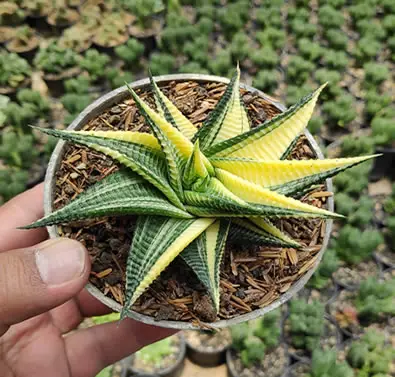
They’re ideal for places with filtered sunlight and minimal humidity.
Try placing one in your home office or bedroom for a low-stress greenery boost.
Outdoor Care
Haworthias can be placed outdoors during the warmer months, but they must be protected from full sun and rain.
Choose a shaded patio, covered balcony, or spot under dappled tree cover.
Bring them back indoors once nighttime temperatures fall below 50°F (10°C), as they are not frost-tolerant.
Use pots that allow for good airflow and drainage to prevent fungal issues from moisture buildup outdoors.
Common Problems and How to Fix Them
Soft, mushy leaves: This is almost always due to overwatering. Allow the soil to fully dry and reduce frequency.
Shriveled, curling leaves: Usually a sign of underwatering or intense sun exposure. Move to a less sunny spot and water thoroughly.
Pale or faded color: Indicates too much direct light. Haworthias prefer indirect or filtered sun.
Stretched growth (etiolation): Caused by insufficient light. Move closer to a window or use a grow light.
Leaf spots or mold: Typically a result of poor air circulation or water sitting in the rosette. Water at the base and improve airflow.
Popular Haworthia Varieties
There are dozens of captivating varieties of Haworthia.
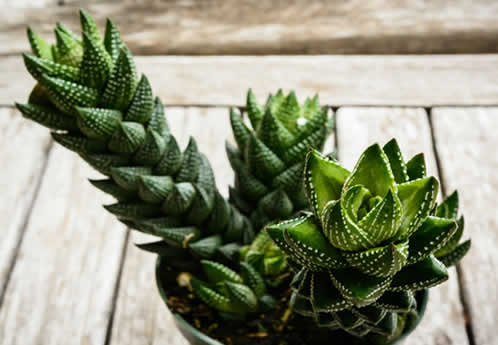
Here are a few varieties, each with unique traits:
-
Haworthia retusa – Translucent, triangular leaves that resemble glossy green stars.
-
Haworthia cooperi – Plump, jelly-like leaves with see-through tips, almost like water droplets.
-
Haworthia zebra – Often confused with Aloe, it has bold white stripes and a spiky shape.
-
Haworthia fasciata – Similar to zebra, but smoother leaf backs and a neater, upright form.
-
Haworthia limifolia – Deep ridged, spiral-like leaf pattern with an almost reptilian texture.
-
Haworthia cuspidata – Tight rosettes with pointed green leaves that often form clusters.
-
Haworthia cymbiformis – Boat-shaped translucent leaves that glow when backlit.
-
Haworthia truncata – Unusual squared-off leaf tips that resemble rows of tiny windows.
-
Haworthia attenuata – Thick leaves covered in raised white bumps, forming striking rosettes.
-
Haworthia coarctata – Stacked, almost column-like form with dense leaf spirals.
-
Haworthia reinwardtii – Elongated, spiky leaves arranged in tall rosettes with fine white tubercles.
Each variety is just as easy to care for as the next, with the same basic needs.
Final Thoughts
Haworthias are the perfect plant for beginners who want a forgiving succulent that’s both decorative and resilient.
With their wide range of textures, shapes, and colors, you’ll never get bored collecting them.
As long as you provide indirect light, good drainage, and minimal water, these South African gems will thrive on your windowsill or desk with very little fuss.
Let them bring a touch of wild desert charm to your home—without any of the maintenance headaches.
Thanks for reading! I'm Michael — houseplant fanatic and your Pinterest plant guide.
Follow me on Pinterest for fresh updates 🌿



